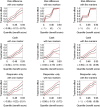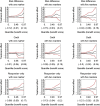Evaluating Markers for Guiding Treatment
- PMID: 27193772
- PMCID: PMC5939825
- DOI: 10.1093/jnci/djw101
Evaluating Markers for Guiding Treatment
Abstract
Background: The subpopulation treatment effect pattern plot (STEPP) is an appealing method for assessing the clinical impact of a predictive marker on patient outcomes and identifying a promising subgroup for further study. However, its original formulation lacked a decision analytic justification and applied only to a single marker.
Methods: We derive a decision-analytic result that motivates STEPP. We discuss the incorporation of multiple predictive markers into STEPP using risk difference, cadit, and responders-only benefit functions.
Results: Applying STEPP to data from a breast cancer treatment trial with multiple markers, we found that none of the three benefit functions identified a promising subgroup for further study. Applying STEPP to hypothetical data from a trial with 100 markers, we found that all three benefit functions identified promising subgroups as evidenced by the large statistically significant treatment effect in these subgroups.
Conclusions: Because the method has desirable decision-analytic properties and yields an informative plot, it is worth applying to randomized trials on the chance there is a large treatment effect in a subgroup determined by the predictive markers.
Published by Oxford University Press 2016. This work is written by US Government employees and is in the public domain in the United States.
Figures


Similar articles
-
Identifying treatment effect heterogeneity in clinical trials using subpopulations of events: STEPP.Clin Trials. 2016 Apr;13(2):169-79. doi: 10.1177/1740774515609106. Epub 2015 Oct 22. Clin Trials. 2016. PMID: 26493094 Free PMC article. Clinical Trial.
-
Outcome prediction for estrogen receptor-positive breast cancer based on postneoadjuvant endocrine therapy tumor characteristics.J Natl Cancer Inst. 2008 Oct 1;100(19):1380-8. doi: 10.1093/jnci/djn309. Epub 2008 Sep 23. J Natl Cancer Inst. 2008. PMID: 18812550 Free PMC article.
-
An ER activity profile including ER, PR, Bcl-2 and IGF-IR may have potential as selection criterion for letrozole or tamoxifen treatment of patients with advanced breast cancer.Acta Oncol. 2009;48(4):522-31. doi: 10.1080/02841860802676383. Acta Oncol. 2009. PMID: 19173092
-
Neoadjuvant tamoxifen and aromatase inhibitors: comparisons and clinical outcomes.J Steroid Biochem Mol Biol. 2003 Sep;86(3-5):295-9. doi: 10.1016/s0960-0760(03)00370-4. J Steroid Biochem Mol Biol. 2003. PMID: 14623524 Review.
-
Anti-tumor effects of letrozole.Cancer Invest. 2002;20 Suppl 2:15-21. doi: 10.1081/cnv-120014882. Cancer Invest. 2002. PMID: 12442345 Review.
Cited by
-
Simple Methods for Evaluating 4 Types of Biomarkers: Surrogate Endpoint, Prognostic, Predictive, and Cancer Screening.Biomark Insights. 2020 Aug 4;15:1177271920946715. doi: 10.1177/1177271920946715. eCollection 2020. Biomark Insights. 2020. PMID: 32821082 Free PMC article. Review.
-
Constructing treatment selection rules based on an estimated treatment effect function: different approaches to take stochastic uncertainty into account have a substantial effect on performance.BMC Med Res Methodol. 2019 Aug 1;19(1):168. doi: 10.1186/s12874-019-0805-x. BMC Med Res Methodol. 2019. PMID: 31370791 Free PMC article.
References
-
- Byar DP, Corle DK . Selecting optimal treatment in clinical trials using covariate information . J Chronic Dis . 1977. ; 30 ( 7 ): 445 – 459 . - PubMed
-
- Sargent DJ, Mandrekar SJ . Statistical issues in the validation of prognostic, predictive, and surrogate biomarkers . Clin Trials . 2013. ; 10 ( 5 ): 647 – 652 . - PubMed
-
- Green SB . Patient heterogeneity and the need for randomized clinical trials . Control Clin Trials . 1982. ; 3 ( 3 ): 189 – 198 . - PubMed
-
- Yusuf S, Wittes J, Probstfield J, Tyroler HA. Analysis and interpretation of treatment effects in subgroups of patients in randomized clinical trials . J Amer Med Assoc . 1991. ; 266 ( 1 ): 93 – 98 . - PubMed
MeSH terms
Substances
LinkOut - more resources
Full Text Sources
Other Literature Sources
Medical
Molecular Biology Databases

